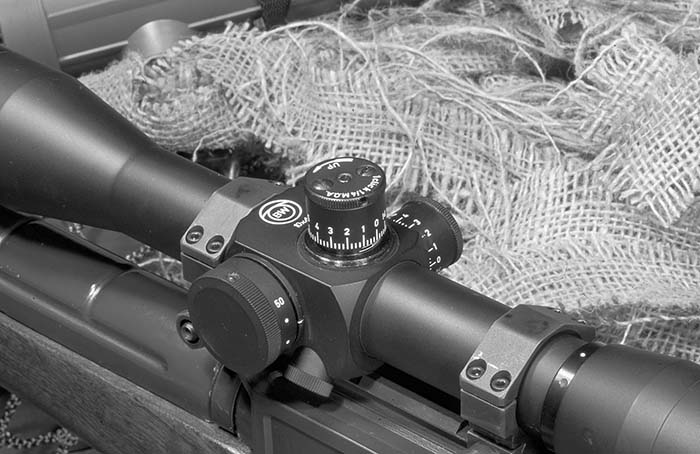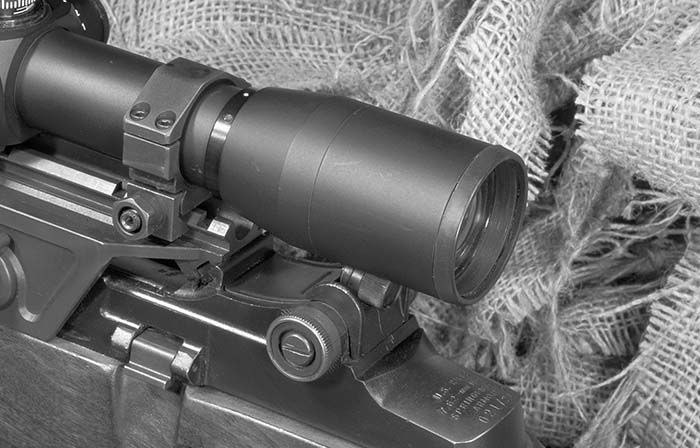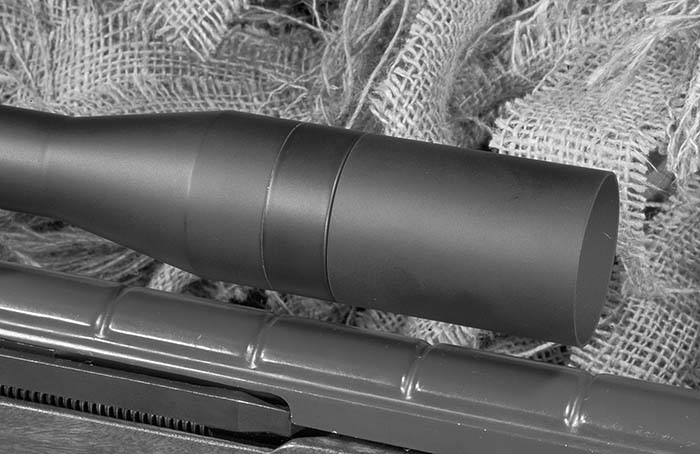By David M. Fortier
Photography by Emily K. Fortier
At first glance the reticle of a riflescope seems like such a simple device. An aiming point placed into the field of view to turn an observation device into a sighting system. However, anyone who has lain behind a rifle for hours shooting at long range knows there’s more to it than that. This is especially true if the reticle is intended for military or law enforcement applications. Much is demanded from any piece of equipment specifically intended for professional use by snipers/marksmen. Even more though is required of their optics. So it was with cautious skepticism that I examined a new proprietary reticle from BW Optics called the Y-Tac.
For a reticle to meet the needs of a modern sniper/marksman it must do more than simply provide an aiming point. It must also provide a means to accurately calculate the distance to a target. While laser rangefinders have come into prominence, they do require batteries and can fail. Therefore a sniper must ideally have the ability to accurately calculate the range to his target using only the reticle in his riflescope. It should also provide reference points for windage and lead corrections. While it’s preferable to dial corrections directly into the scope this is not always possible. This is especially true on a quick follow-up shot or when engaging moving targets. The aiming point should also be distinct, even in lowlight, and quick to pick-up. Yet, it must also be precise enough to allow precision fire at long range on small and partially obscured targets.
A reticle, like the optic itself, is a combination of very carefully made trade-offs. While a fine crosshair provides a very precise aiming point on small targets at long range, it’s slow to pick up and difficult or impossible to discern in lowlight. On the other hand while a heavy German post is quick to pick up and remains visible even in lowlight it covers up much of the field of view. While there is no “perfect” reticle there are some very good designs that work well in a variety of applications.

To review this design we had BW Optic send us a 10x42mm fixed power tactical scope for testing. While BW Optic designed the reticle, their scopes are manufactured by Industry Optic Romania (I.O.R.) of Bucuresti, Romania. Producing optics for sniper rifles is nothing new to them. Started in 1936 in the South Eastern part of Romania, Industry Optic Romania was the creation of three very prominent European corporations, Malaxa-Carp, Optique De Le Vollois, and Bernard-Turnne. These three companies initiated what was to become one of the largest producers of military optics in the world.
Shortly after its birth, I.O.R. played a prominent role in supplying military optics for the Axis, and then Allied, war effort. At the beginning of World War II, Romania allied itself with Germany and fought against Stalin’s Red Army in an effort to win back lost territory. At this time I.O.R. was hard pressed manufacturing high precision military field optics (such as binoculars, altimeters, compasses) and aiming apparatus for fighter planes, submarine periscopes, giant naval anti-aircraft binoculars, artillery trench rangefinders, etc. Of interest to us is the fact that they also produced sniper riflescopes and mounts for the Vz24 sniper rifle in service with the Romanian Army at that time. This Luneta 4.5x28mm unit remained standard issue for Romanian snipers until finally replaced in 1979/80. At this time, the aging Vz24 Mausers were retired in favor of the new self-loading PSL (Puska Semiautomata Luneta) sniper rifle. I.O.R. optics also topped this new sniper rifle, which is currently fielded by Romanian troops in Afghanistan.
After World War II, I.O.R. found itself trapped in the Soviet sphere of influence. However, they maintained close ties with certain German companies. Then in 1967 I.O.R. started to expand their collaboration with the giant German manufacturers of Pentacon, Fog-Gorlitz and Schneider. During this time they continued to produce military optics as they had previously. In 1975 an increased level of collaboration with Carl Zeiss, Hensoldt, and Leica began. This is of particular interest to us as these highly respected German optics manufacturers took a keen interest in I.O.R. Carl Zeiss in particular played a key role in modernizing I.O.R. with not only the latest equipment, but also the training required to use it. In 1989, I.O.R. entered the fields of opto-electronics and thermovision. After the wall came down in the 1990s, they entered the US market and currently offer a line of professional-grade tactical riflescopes and binoculars.
Riflescopes from BW Optic are manufactured to their specifications by I.O.R. What sets them apart is their proprietary Y-Tac reticle. This is an interesting combination of a post reticle and our Mil-Dot system. The heart of the reticle is a post aiming point with “wings.” This is intended to resemble the front sight assembly on a US military rifle, such as an M14 or M16, complete with protective ears. The post is 1 Mil in height and 0.25 Mil wide and is intended to be easily seen even in lowlight. The “wings” are precisely designed to range a B-27 (shoulder width) target. They also facilitate rapid target acquisition.

Beneath the post is a vertical stadia. This is intended to be used for rangefinding via the Mil system and for elevation holdovers. To facilitate this, the 10 Mil high stadia is divided in not only 1 Mil increments but also 1/2 Mil increments. In addition, the vertical stadia above the post is divided into 1 Mil increments for an additional 5 Mils. To prevent canting, a horizontal stadia is incorporated. This is divided in 1 Mil increments for hasty windage or lead corrections. In the lower right field of view (FOV) is a choke style rangefinder. This is configured to measure a 21.6-inch-wide (shoulder width) target from 200-1,000 yards. This reticle is currently available in four different tactical scopes from BW Optic. Models consist of 2.5-10x42mm and 4-14x50mm variables as well as 10x42mm and 6x42mm fixed powers.
The 10x42mm Tactical we received for testing was a good looking medium-size tactical scope. It featured a 42mm objective lens, fixed 10x magnification, and a beefy mechanism block. Overall length is 13.25 inches and it weighs in at 22 ounces. Tube diameter is a conventional 30mm. In European tradition the ocular features a quick focus eyepiece. This latter feature ensures the reticle and image is always in the same plane for a crisp sharp image. Field of view is a healthy 14 feet at 100 yards. In comparison, a 10x42mm Leupold MK 4 sports an 11.1 foot FOV and a 6×42 M8 a 17 foot FOV at 100 yards. Exit pupil is 4.2mm and eye relief is 3.75 inches.
Finish is a matte black and the mechanism block sports large capped target turrets. Removing the caps reveals nicely marked turrets featuring 1/4 MOA adjustments in very distinct tactile and audible clicks. One counter-clockwise turret rotation dials in 15 MOA of elevation. The turrets are marked to allow an operator to keep track of full turret rotations. This is a good thing as this scope sports a whopping 100 MOA of elevation adjustment. This is a full 10 MOA more than Leupold’s 10×42 MK 4. On the left side of the mechanism block is a knob to adjust parallax. This is marked from 50 yards to Infinity. To the rear of this is a Magnum Lock Support that engages the reticle. The reticle itself is photo engraved directly onto glass so there is no chance of breakage. For superior durability this model features a Milspec steel tube, is O-ring sealed, and nitrogen filled. It comes with a screw-on sunshade.
As far as the optics of this scope are concerned the lenses themselves are manufactured in Romania from optical glass produced by Schott Glasswerk of Germany. Schott, a Carl Zeiss subsidiary, produces optical glass that is widely regarded as the finest in the world. The lenses are coated with the T-3 system as developed by Carl Zeiss. This consists of fully multi-coated lenses with anti-reflex treatment to eliminate glare and maximize light transmission.
To test this scope and its proprietary reticle we mounted it onto a Springfield Armory National Match M-1A via a Brookfield scope mount and I.O.R. HD 30mm tactical rings. We began our testing by evaluating it for fit, finish, and mechanics straight out of the box. Here we found it to be a good looking and nicely put together scope. The Quick Focus eyepiece rotated easily and the parallax knob adjusted smoothly. Turret adjustments were among the best we have ever seen. Whereas many tactical scopes (Leupold, Springfield Armory, Nikon, Kahles) feature “mushy” clicks, the BW Optic’s were precise, tactile, and audible. Aesthetically, it’s a good looking scope, but to be frank not quite in the league (pertaining to finish) of Schmidt & Bender or Carl Zeiss.
We then moved to checking it optically with a Zeiss Test Pattern. Posting the ZTP at 50 yards we noted the 10x42mm possessed excellent color rendition and contrast. Resolution was also quite good and we were able to resolve down to the #2 block on the ZTP. Examining the image on the ZTP we noted no astigmatism present. Unlike most scopes the image did not degrade moving from the center to the edges and we noted no curvature of field or spherical aberration. In this regard the Romanian optics are quite impressive.
Distortion comes in two basic forms: pin cushion or barrel, and I detected neither present in this scope. No rolling distortion was detected either. However, we did note some internal flare when looking in the general direction of the setting sun. This is a loss of contrast and sharpness caused by stray non-image forming light reflected from inner lens surfaces. In this regard I did not feel the T-3 lens coatings were quite the equal of Carl Zeiss’s top of the line T*. So what does all this mean? Simply that this is a very impressive piece of glass with excellent color rendition and extremely good resolution well up to the task at hand.

With the optical testing out of the way we zeroed at 100 yards. As extreme cold is very hard on any optical device’s internal mechanism all testing was performed at temperatures ranging from 30 degrees F to -12 degrees F. Firing groups on paper we noted the flat post, although very different from conventional crosshairs, did provide a distinct aiming point. Finding the reticle easy to use on paper in bright light, we waited for the sun to go down to do some lowlight testing. With the sun fading we were still able to effectively employ the post reticle after a conventional Mil-Dot reticle had disappeared into the shadows.
We then moved from the bench to shooting at unknown distances on silhouettes. We began by engaging targets from 170-330 yards with rapid multiple shots. This was performed in both bright and lowlight. Here the Y-Tac reticle came into its own. The post and wings configuration stood out clearly, was very fast on target, and was visible when a conventional reticle was difficult or impossible to discern. Next we increased the range, engaging targets from 400-700 yards. At these distances I noted the 10x42mm’s adjustments were perfect, for both elevation and windage, throughout their range. Repeatability was flawless. Turret markings were easy to read and rotations simple to keep track of. First round hits were made out to the limits of our testing, 700 yards.
My original concern when first looking at this reticle was that it might be too coarse when shooting at long range. However, I found that I could precisely index the head of a silhouette with the post, even at 700 yards. Firing slow groups prone off a pack, the M-1A shot into 1 MOA out to 700 yards. With its high round count and worn bedding this is all that can be expected from this particular self-loading rifle. The BW Optic’s Y-Tac reticle allowed you to place that 1 MOA group wherever you liked though. Taking my time I went 4 for 5 on the 700 yard silhouette’s head.
When it comes to rangefinding the Y-Tac gives you three options: a Choke rangefinder, the Mil-System, and the Y-Tac wings. To utilize the Choke rangefinder simply place the left shoulder of your target against the vertical line. The line where their right shoulder touches is the range they are at. The reticle is also delineated in Mil’s, so you can conventional Mil any object and mathematically calculate the distance. Or you can utilize the reticle’s wings to range a figure. Using this system: if the outer edges of the wings are the same distance as a man’s shoulders, he is 150 yards away. If his shoulders come to the inner points, he is 200 yards away. If his shoulders come to the outer vertical edges, he is 300 yards away. If his shoulders space between one outer and one inner vertical edge, he is 400 yards away. If his shoulders just fit between the inner vertical edges, he is 500 yards away. With this system you don’t need a standing figure to be able to range them. All you need is to be able to see their shoulders.
Negatives? The only real negative is the fact that the wings and Choke rangefinder are calibrated for a 21.6-inch-wide target. Look around you, people vary greatly in size and width. This is a weakness inherent in all Choke rangefinders. Also some may find the reticle a bit cluttered. Lastly it’s not cheap, retailing for $949.
We came away impressed by both the Y-Tac reticle and the scope that houses it. The reticle indexes quickly onto a target, stands out even in lowlight, and is an aid when estimating range. While it’s different looking, it is well thought out and effective.
Specifications
Magnification: 10x
Objective lens diameter: 42mm
Tube diameter: 30mm
Field Of View @ 100 yards: 14 feet
Eye Relief: 3.75 inches
Length: 13.25 inches
Weight: 22 ounces
Adjustments: 1/4 MOA
Total Adjustments: 100 MOA
Price: $949
Source
BW Optic
P.O. Box 355
Simpsonville, SC
29681
864-297-4137
BWOPTIC@AOL.COM
| This article first appeared in Small Arms Review V7N1 (October 2003) |










